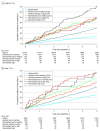Frailty Trajectories Following Adjuvant Chemotherapy and Mortality in Older Women With Breast Cancer
- PMID: 40072432
- PMCID: PMC11904708
- DOI: 10.1001/jamanetworkopen.2025.0614
Frailty Trajectories Following Adjuvant Chemotherapy and Mortality in Older Women With Breast Cancer
Abstract
Importance: Frailty assessed at a single time point is associated with mortality in older women with breast cancer. Little is known about how changes in frailty following cancer treatment initiation affect mortality.
Objective: To evaluate the association between claims-based frailty trajectories following adjuvant chemotherapy initiation and 5-year mortality in older women with stage I to III breast cancer.
Design, setting, and participants: This longitudinal cohort study used the Surveillance, Epidemiology, and End Results cancer registries linked to Medicare claims data (claims from 2003-2019). Women aged 65 years or older with stage I to III breast cancer diagnosed from 2004 to 2017 were included. Eligible women underwent breast surgery followed by adjuvant chemotherapy as initial treatment. A landmark design was used to identify frailty trajectories during the year following chemotherapy initiation. Continuous enrollment in Medicare fee-for-service from 180 days before cancer diagnosis through 360 days following chemotherapy initiation (landmark) was required. Women who died or disenrolled before the landmark were excluded. Analyses were conducted between September 2022 and March 2024.
Exposures: Claims-based frailty trajectories during the 360 days following chemotherapy initiation were identified using the Faurot frailty index, a validated claims-based proxy for frailty based on demographics and diagnosis, procedure, and durable medical equipment claims. The Faurot frailty index was calculated every 30 days from chemotherapy initiation through the landmark (360 days after chemotherapy initiation). Claims-based frailty trajectory clusters were identified using longitudinal K-means clustering.
Main outcomes and measures: Associations between the claims-based frailty trajectory clusters and 5-year mortality from the landmark were estimated using Kaplan-Meier analysis.
Results: In total, 20 292 women with breast cancer (median [IQR] age, 70 [67-74] years) were identified. The K-means analysis resulted in 6 trajectory clusters: 3 robust (16 120 women [79.4%]) or resilient (3259 [16.1%]) trajectories and 3 nonresilient trajectories (913 women [4.5%]). Five-year mortality was higher in women belonging to the 3 nonresilient trajectories compared with those belonging to the 3 resilient trajectories (52.1% vs 20.3%; difference, 31.8%; 95% CI, 29.0%-36.2%).
Conclusions and relevance: In this cohort study of women with stage I to III breast cancer, frailty changes following chemotherapy initiation were associated with long-term survival. Future research should assess the association of frailty interventions following cancer treatment initiation with survival and patient-centered outcomes in this population.
Conflict of interest statement
Figures



References
-
- National Cancer Institute . Surveillance Epidemiology and End Results (SEER) Program. Cancer stat facts: female breast cancer. Accessed December 13, 2022. https://seer.cancer.gov/statfacts/html/breast.html
-
- Howlader N, Noone AM, Krapcho M. SEER cancer statistics review, 1975-2016. 2019. Accessed February 3, 2025. https://seer.cancer.gov/archive/csr/1975_2016/index.html
Publication types
MeSH terms
Grants and funding
LinkOut - more resources
Full Text Sources
Medical

